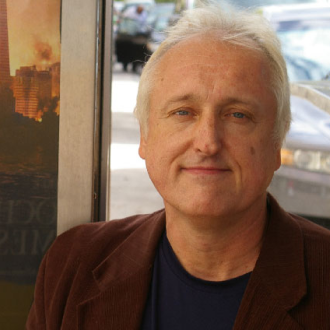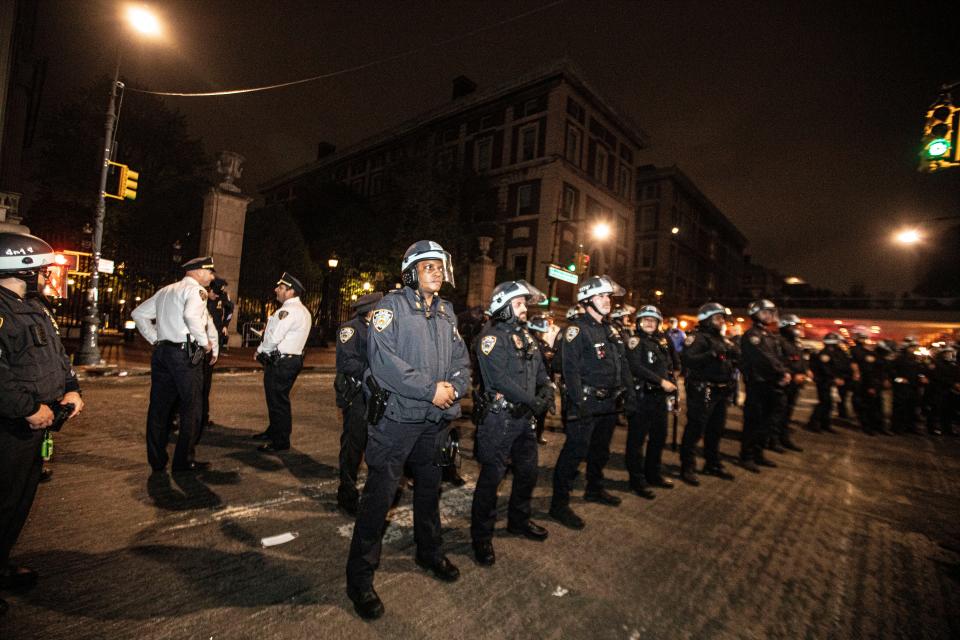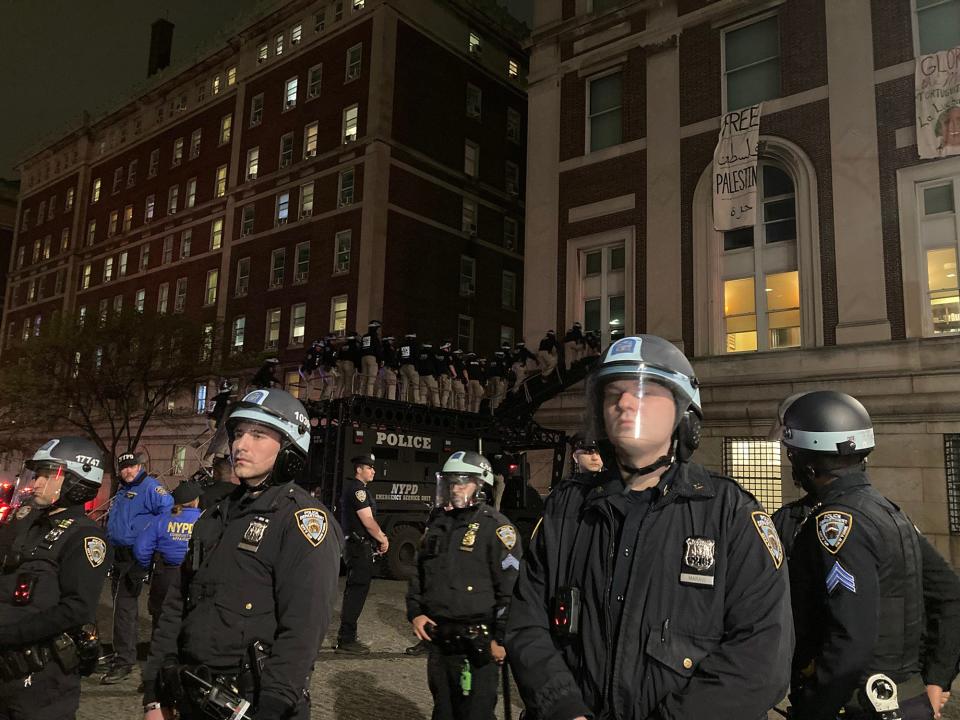A Columbia professor wanted to document history. NYPD arrested him outside his home
Gregory Pflugfelder had just finished the final class of his career at Columbia. In 28 years at the university, he achieved many accolades as a professor of history who taught a popular course on Japanese monsters – mostly focused on Godzilla and "the role of the monstrous in the cultural imagination."
He didn't know it, but a cultural monster of sorts would soon be at his door.
The next night, on Tuesday, the 64-year-old silver-haired scholar stepped outside his apartment building, located off campus across the street from Columbia. He wanted to record iPhone video of hundreds of police responding to historic student protests against Israel’s war in Gaza. Fifteen minutes later, the NYPD arrested him.
The New York Police Department listed Pflugfelder among 112 arrests made at Columbia on Tuesday night, according to police records obtained by USA TODAY. But Pflugfelder was never on campus.
“I certainly posed no danger to anybody,” he told USA TODAY. “I was literally standing in the street and not blocking anybody.”
As protests and opposition to the war in Gaza has swept across U.S. campuses, universities and police have increasingly pointed to "outside agitators" and off-campus disruptors as the insurgents behind the campus unrest. Pflugfelder's arrest – on a charge of obstructing government administration – is among the first of 282 people put in custody at or near Columbia and City College of New York during police raids. The arrests have raised claims of heavy-handed police tactics to suppress largely peaceful demonstrations against the Israel-Hamas war.
Columbia University referred questions about the professor’s arrest to NYPD. Neither NYPD nor New York Mayor Eric Adams’ office responded to email requests from USA TODAY.
Live updates: NYPD says officer fired gun on Columbia campus; NYU, New School protests cleared

'Historic mistake'
Pflugfelder's last class, Introduction to Japanese Civilization, is a course he taught since he started teaching at Columbia in 1996. He's only taught at the Ivy League school. His plan Tuesday was to do “absolutely nothing,” he recalled. This included reading and watching the Hulu show, "Shōgun."
In the afternoon, he heard protests nearby, around the corner from his apartment on West 114th Street. His apartment building is located across the street from campus, where demonstrators gathered for weeks and formed an encampment calling on the university to divest from Israel.
He knew about the heightened police response because of a prior protest at Columbia, on April 18, at which police arrested over 100 people at the encampment in the center of campus. Police buses blocked Pflugfelder's street to take protesters to NYPD headquarters.
He supported students right to demonstrate. He wrote a letter to Columbia President Minouche Shafik, who requested NYPD respond to the encampment on campus. It was his first time writing to the president’s office. “I urge you not to compound the historic mistake you've made by repeating it,” he wrote on April 23.

A week later, on Tuesday, he felt history would be made again, and he wanted to document it. He stepped out of his apartment building to record video on his iPhone.
By about 9 p.m., he estimated hundreds of police, donning helmets and batons, had formed lines on the street. He recorded students forced inside fraternity houses and dorm buildings, with video of them knocking on the windows. Then, he turned to look at the street, where officers formed lines ahead of their siege on campus.
At most, he said, he stood 7 feet onto the street from the curb. Police ordered him inside, but he told them his address was about 300 feet down the block. They told him to go home, but he said he wanted to continue recording. An officer said, “OK, put him down,” Pflugfelder recalled, though he was not forced to the ground. Nonetheless, he ended up cuffed in zip ties.
“I just stayed on my block, relatively well behaved,” he said. “Poorly located, unfortunately.”
He said he told the female police officer arresting him: “You’ve just arrested your first faculty member.” He said she responded, “This is for your protection.”
Police response to NYC schools showed 'precision policing,' Adams says
Mayor Adams has said police acted with professionalism in mass arrests on college campuses, which included police using a SWAT vehicle to enter Hamilton Hall, the occupied Columbia building.
"The NYPD's precision policing ensured that the operation was organized, calm, and that there were no injuries or violent clashes,” Adams told reporters on Wednesday, the day after the arrests.
But Jennvine Wong, supervising attorney at the nonprofit Legal Aid Society’s cop accountability project, said Pflugfelder's arrest raises questions about whether NYPD escalated rather than deescalated situations. It also may have violated laws protecting citizens’ right to record police interactions.
“Generally speaking, there is still a First Amendment right to record in public as long as they’re not interfering with police,” Wong told USA TODAY. “To me, this sounds like a devious arrest.”
War in Gaza: Biden to meet with King of Jordan as US, Israel go 'back and forth' over Rafah invasion
By Pflugfelder’s account, he was the third arrested person to enter an NYPD van. Ten people would fill the van that took him downtown. At 6-foot-5-inches, Pflugfelder said he felt cramped. He also has “claustrophobic tendencies,” and during the ride, he asked others to help him take his mind off his feelings, so they asked about his classes. He gathered during the ride that most people inside were Columbia students, based on the questions they asked.
At NYPD headquarters, he was in a holding cell with about 60 other men. He stayed there for about five hours. One person next to him on the bench said he was from Columbia and had been at Hamilton Hall, the occupied school building police raided using flash-bang grenades, and where police errantly fired a gunshot indoors. The man Pflugfelder saw was visibly bruised, including a black eye.
“The violence against protesters was extreme,” said Corinna Mullin, an adjunct assistant professor of political science at John Jay College of Criminal Justice, part of CUNY, at a recent news conference. Mullin was among those arrested Tuesday night at City College.

Conclusions drawn, then data collected
Police released Pflugfelder from custody at about 5 a.m. with a ticket to appear in Manhattan Criminal Court on May 20. He called an Uber and went home, though since has found it hard to rest. He’s hasn't yet communicated with university administration. He’s not looking forward to it.
“I would not put myself in a vulnerable situation vis-a-vis an institution that has assaulted me,” he said.
Irene Mulvey, the president of the American Association of University Professors, said the group has several firsthand, eyewitness accounts of what she called unnecessarily violent and disproportionate responses to what started as peaceful protests.
Information released by police, including on the number of “outside agitators,” has not answered important questions about the rationale to send police to college campuses, including at Columbia, said Mulvey, a mathematician and professor emeritus at Fairfield University, in Connecticut. A central reason police responded to Columbia was people from outside who indoctrinated students with training and ideology, though officials have disclosed little evidence to date.
“Scientists, we would collect data and draw conclusions,” she told USA TODAY. “In this case, it seems a conclusion was drawn, and then data was collected, which may or may not justify it.”
Pflugfelder has yet to have the relaxing day he’s sought after nearly three decades of teaching. In jail, police made him remove the shoelaces of his black and white Vessi sneakers. He’s kept them unlaced since then, as a reminder.
Contributing: Mike James, USA TODAY
This article originally appeared on USA TODAY: Columbia professor arrested outside his home in NYPD campus raid
